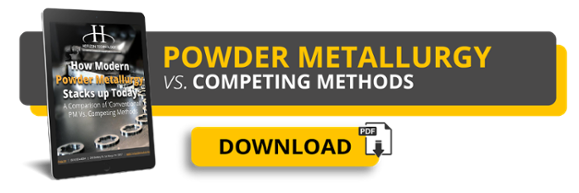If you’re new to powder metallurgy or aren’t involved in the design process, the difference between sintering and melting can be hard to find.
If you could ask the metals involved, they’d probably tell you it’s a simple matter of hot vs. hotter. But from a quality and flexibility standpoint, there are very significant differences between the two processes. These differences will help an engineering team decide how and when to use melting or sintering for metal parts manufacturing.
Differences Between Sintering and Melting -- What the Engineer Needs to Know
From a metal parts-making perspective, melting is virtually exclusive to casting*. Why the asterisk? We’ll leave you in suspense for now.
Sintering, meanwhile, is exclusive to powder metallurgy (PM) in terms of metal manufacturing. It’s also the core process in ceramics making.
What Is Melting?
Melting is a relatively simple process compared to powder metallurgy. You take all the alloys you need to improve your part’s properties and place them in a furnace. The manufacturer will set the furnace to a temperature above the melting point of the most prevalent metal in your mix. This will cause the metal to become liquid.
Different elements have different melting points, so furnace temperatures are adjusted on a case-by-case basis.
In metal parts manufacturing, melting is used for casting -- where the manufacturer pours the liquid metal into a die (or mold) to create a specific shape. Once the metal cools, the casting is removed from the mold, and you have your finished shape (more or less).
A good example of casting in modern manufacturing is the engine block. Sure, you could machine it, but that’d be pretty expensive. Powder metal is out of the question because engine blocks are too big to be compatible with PM equipment. So instead, you melt the base material, pour it into the mold, and you’re all set.
At one time, all engine blocks were cast iron. Today, they’re aluminum. Be it iron or aluminum, the process is the same, minus the melting point.
What is Sintered Metal?
Before any heating takes place in powder metallurgy, a compaction device presses the particles of your metal mix together. From there, it goes in the sintering furnace.
The sintering furnace applies enough heat to further bond the particles -- but not enough heat to reach the melting point of your alloying elements.
The steps in powder metallurgy sintering include:
- Lubrication removal
- Oxide reduction
- Particle bonding
- Cooling
There are different atmospheres your manufacturer can use in the sintering furnace depending on the needs of the component. One common theme is keeping the threat of oxidation away.
While these four steps are used with every sintering job, the exact sintering process depends on the end use you have in mind.
- Some sintered metal parts are structural
- Some are sinter-hardened
- Some are soft magnetic materials
Each type of part requires tweaking to the sintering process. For example, structural parts require maintaining the carbon content of the PM steels for strength and hardness and can be rapidly cooled in the sintering furnace. Thus, the sintering temperature, cooling rate and atmosphere is specifically designed for these requirements. Conversely, sintered soft magnetic materials require a sintering atmosphere that eliminates carbon from the part and once sintered the parts are slowly cooled to optimize the magnetic performance. Soft magnetic composites are not sintered; instead they’re “cured” at a temperature well below the sintering temperature of iron.
Remember that asterisk from before? Most engineers think of melting as something you’d only do in casting, but sometimes it’s actually part of the sintering operation too. To join powder metal parts, you can apply a brazing alloy that melts and partially infiltrates each part to create a stronger joint.
Why Would You Consider PM Vs. Casting?
You can melt metals like iron and nickel without too much trouble. But refractory metals -- tungsten, molybdenum, for example -- have such high melting points that you can’t cast them. This automatically rules out certain products from being cast -- products that require the exceptional heat and wear resistance of a refractory metal.
Long ago, incandescent lights were a good example of this roadblock. The tungsten in the bulbs required powder metallurgy processes because of the need for an ultra-hot furnace. (This PM processing of tungsten for light bulbs is often considered the birth of modern powder metallurgy.)
At the end of the day, the only reason you use melting is because you’re trying to either create an extremely intricate shape or because the part size is too big for PM equipment to handle. Casting can give you intricate shapes and large shapes, but its drawbacks are considerable:
- The cooling process can be time-extensive for casting.
- It’s very difficult to hold tight dimensional tolerances.
- There will almost always be additional machining necessary afterward to “qualify” the part, making lead times and manufacturing costs higher
More Than Just Temperature
As you can see, the matter of sintering vs. melting is more than just a contest of which can bring the most heat.
Consult with engineers on both your side and a potential part supplier’s side to make sure you’ve got the right process in mind. You can also consult the free e-book below to see more about the disadvantages and advantages of powder metallurgy vs. casting, machining, and stamping:



